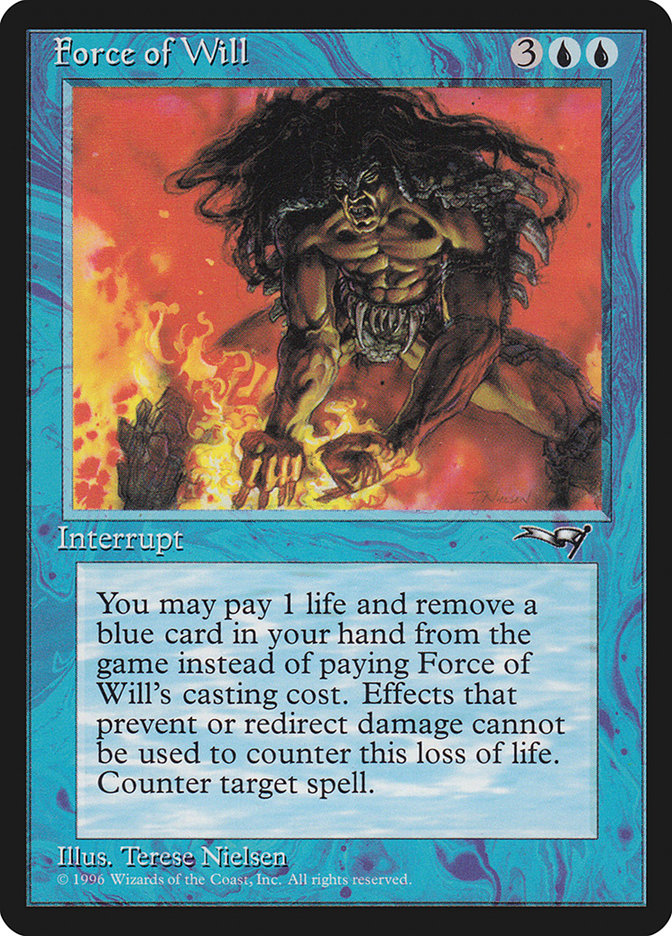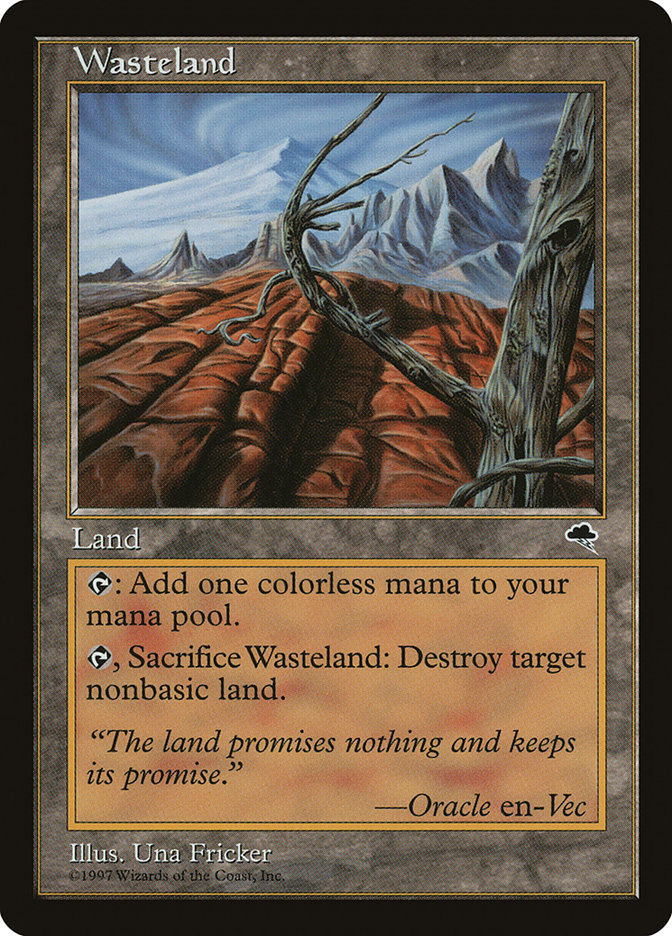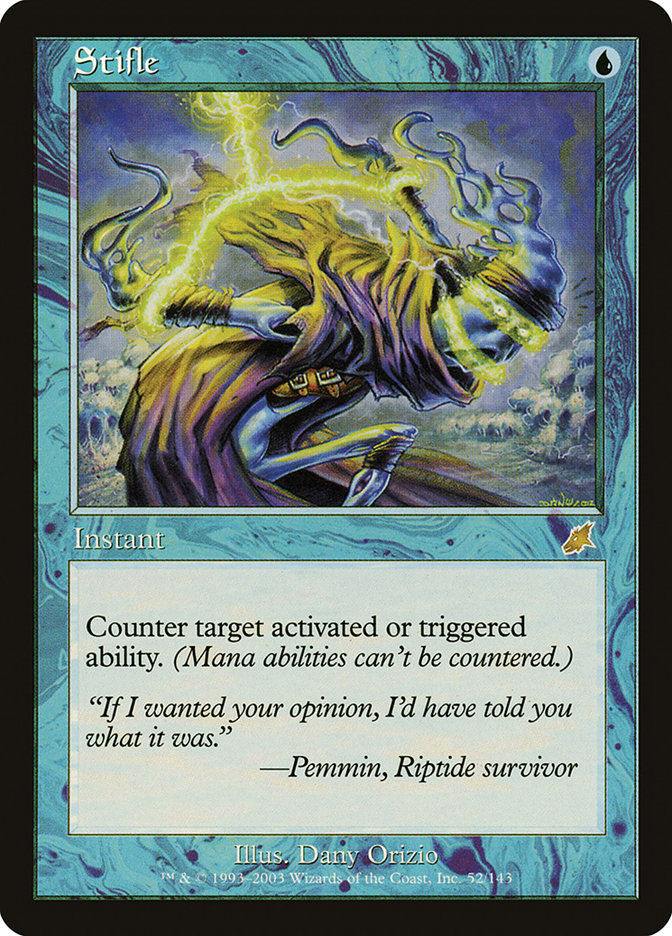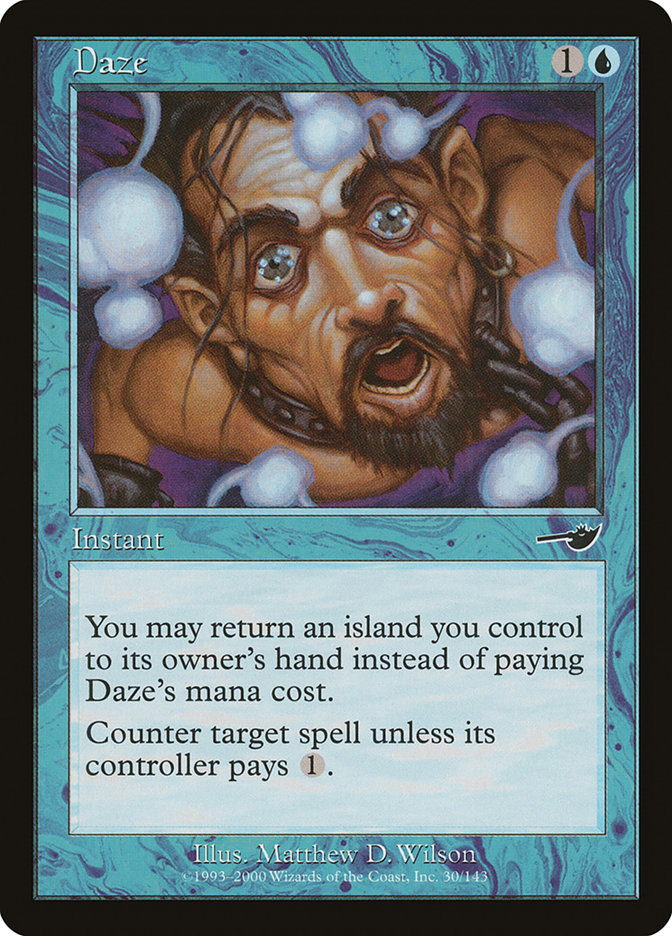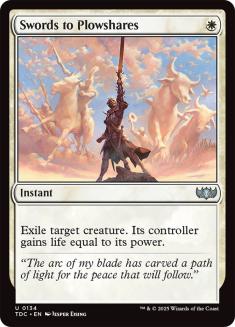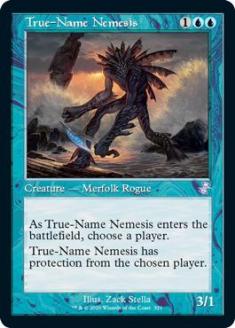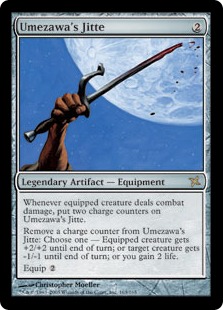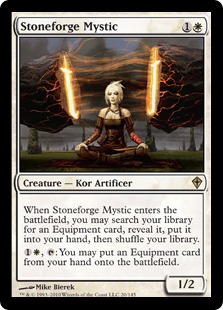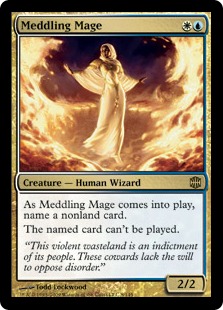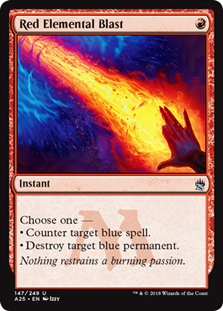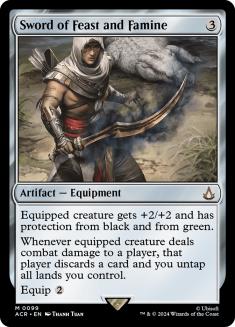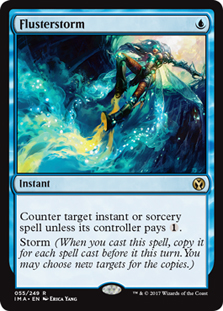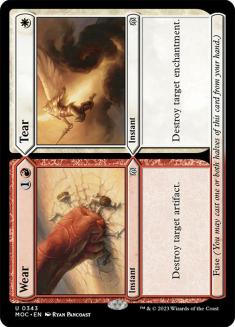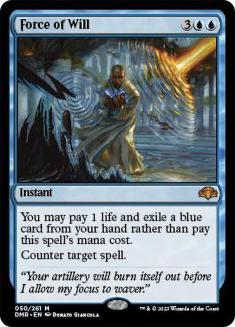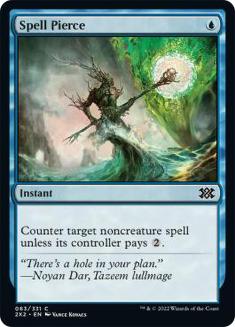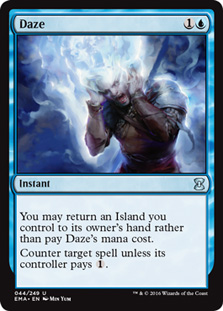Legacy has been kind to me, and it feels good to finally win something.
Despite having some degree of success with a few different decks in the format, I have never strayed from playing Stoneforge Mystic and firmly believe that U/W/R Delver is currently the best Stoneforge deck.
Today I want to discuss some general facets of playing U/W/R Delver and "fair" Legacy in general. Although I have minimal experience playing combo and other degenerate strategies, I do feel like I can comment with some level of expertise on how to navigate Legacy by honest means.
One could argue that it’s nearly impossible to play a perfect game of Magic, and in Legacy this notion holds particularly true. The large degree of high-impact spells and deck velocity that litter the format make every decision extremely important since every mistake compounds quickly. As a result, it is my belief that it is particularly important to identify the correct line available and simply try to execute as best as possible. This is why I value information so highly.
My only change to the maindeck of Owen Turtenwald’s winning decklist from Grand Prix Washington DC was the inclusion of three copies of Gitaxian Probe. The ability to sequence spells in an optimal manner at little to no cost is key, and although some would describe Probe as "training wheels," I consider it among the best cards in the deck due to the fact that the potential range of what opponents can play is so large.
Here is the list I used to win the SCG Legacy Open at the Season One Invitational in Charlotte:
Creatures (10)
Lands (19)
Spells (31)

The Three Pillars
When discussing interactive Legacy, I believe there are three pillars of the format.
Brainstorm is the most powerful card in the format. If it is not cast as a virtual Ancestral Recall to set up a winning line or out of sheer desperation, then it is being used incorrectly. Most people understand by now that Brainstorm should usually be cast in the main phase with the immediate intention of shuffling away two dead cards. It is particularly important in the first game with U/W/R Delver because the deck contains both a large amount of removal and disruptive elements and finding the correct half of the deck for the matchup is key.
When setting up Brainstorm, it is vital to wait and see as many cards as possible. Particularly if you have a board presence and meaningful ways to interact with your opponent, there is no reason to cast it. Generally speaking, the best way to sequence your cantrips is as follows—Gitaxian Probe to dig a free card and identify the optimal line, Ponder to get the best specific card for that turn, and then Brainstorm to restock your hand. As far as the minute details of playing Brainstorm, I encourage everyone to watch this episode of AJTV. Instead, I want to delve into the details of playing against opposing cantrips.
It is important—particularly against combo decks—to fight their cantrips, especially Brainstorm. Delver has a large amount of soft countermagic, and nearly every combo deck has some degree of fast mana. Unless they are under extreme pressure, combo will be able to set up a perfect hand that is able to fight through Daze and Spell Pierce. Daze especially is unreliable and should be used aggressively if given the opportunity. Again, Gitaxian Probe is great in allowing you to judge the strength of an opponent’s hand and pick your battles.
I will almost always Red Elemental Blast a Brainstorm in post-board scenarios due to the fact that it is narrow and most degenerate decks contain a nonblue combo piece. Another way to cripple an opposing Brainstorm is to force them to crack their fetch land in play. This severely weakens their Brainstorm and can be accomplished by Wastelanding their fetches in addition to soft counters forcing them to be used to pay.
Force of Will is the card I value the most to have in my opening hand in the dark, especially on the draw. Although playing Force is a necessary evil for fighting combo decks, there are some things to keep in mind regarding it. First, you will always be down a card in the exchange. I will often remove a Force to itself if I draw multiples and cannot Brainstorm them away. Trying to win any long grind of a game will be difficult down two cards, even if the Force can cement a short-term tempo play.
Second, although Force backup may make it appear that it is safe to aggressively cast your spells, in reality it often just livens up the opponent’s soft countermagic and will result in any losing exchange costing a ton of resources. It is risky to tap out in the early stages of the game with the intent of fighting back with Force of Will. This leads to my next point—the card is typically bad in any kind of fair matchup and is frequently the one I will at least shave some copies of first, especially in Delver mirrors.
However, despite all of this games will often progress to the point where you will be committed to defending a key threat with Force in the later stages of the game. An important part of playing Legacy in general is getting over the fact that your resources are often exchanged quickly and aggressively. Having the courage to commit several cards and the ability to quickly shift roles when necessary is vitally important to playing any kind of Delver strategy.
These three cards are what I try to take into account with every mulligan decision. Playing around the opponent’s mana denial within reason will allow you to not give away free games. Unfortunately, it is difficult to play around all three simultaneously, so there is a fair amount of hedging involved.
Generally speaking, Wasteland is by far the most prominent. Due to the fact that U/W/R Delver contains no basic lands, it may often be correct to lead with a Ponder instead of a Delver in hopes of finding a second colored source. Furthermore, you can simply not crack your fetch lands and sit on them to acquire more information before moving in any direction. It is possible although difficult to set up a sequence where you can return your own land with Daze. Trying to Brainstorm or cast a removal spell as a response to their Wasteland may initiate them to fight, with which you may pick up your land for a lot of value.
Stifle is only prominent in RUG Delver currently, and thus I will not go out of my way to play around it unless I know that is the matchup. If you do know Stifle is present, then look for key moments to crack your fetch lands if your opponent is mana light, using them and your Wastelands during their upkeep to overload their mana. If you in fact have a mana-heavy hand, you can often trick the opponent into Stifleing a fetch land before leading into Stoneforge Mystic on your next turn. People will often Stifle as soon as possible due to the risk of never getting value from it.
Daze is both the easiest card to play around and holds the most upside in choosing not to. Delaying all of your plays by a turn has a real cost; however, it may be necessary depending on how mana heavy your hand is and how much pressure you are under. In general I like to play around Daze rather aggressively due to the fact that it is often free to do so, but I will often mix it up in post-board games if my opponent is on the draw and I believe there is a sizeable chance they have boarded it out.
Daze in combination with opposing Wastelands is when things become truly difficult. Then it often becomes a question of whether you can afford to play around Daze to begin with and typically comes down to how likely it will be to stabilize the board if you wait to cast your spells for a turn. If forced to go down this path, it is important to lead with your least powerful spell. As with Stifle, if the opponent doesn’t immediately capitalize, it is often safe to assume the coast is clear.
Unsurprisingly, Gitaxian Probe is incredible at dissecting your opponent’s mana denial strategy and determining which sequence to choose or how aggressive you may be. The ability to pick how to play around these common mana denial cards is another huge draw to playing Probe in your deck.
Playing U/W/R Delver
The most important aspect of Delver decks or any aggro-control strategy is leading the game state to the point where you have a meaningful clock on your opponent. This doesn’t even necessarily mean that you are going to kill them quickly; rather you are constricting their draw steps while effectively mitigating what they are capable of doing. Against creature decks your plan is often to attack with a Stoneforge Mystic wielding a Jitte, which quickly eliminates anything relevant they can do before killing them five or so turns later. Combo matchups are merely about eliminating the possibility of them constructing a perfect hand by attacking them with anything while finding and utilizing your disruptive elements.
The distinction between U/W/R Delver and other forms is that the deck is slower and has a better late game. Equipment, True-Name Nemesis, and Swords to Plowshares can make the deck function like a backward midrange deck in some scenarios, and despite the fact that in no particular matchup do we actively want the game to go late, it is certainly not impossible to win later with proper management of our threats.
Due to the fact that the deck is slower and doesn’t play as many high-power threats like Tarmogoyf, often games will progress in the following manner: avoid dying –> create a clock –> close out the game. As a result, it is key to keep this in mind when resolving early cantrips. If your hand is adequate but does not contain a threat, it is vital to aggressively shuffle with Ponders and cast Brainstorms in attempts to find one. Cards like Daze and Spell Pierce begin to lose value the longer the game progresses.
Beyond having a plan, it is difficult to communicate objectively how to play a game of Legacy correctly. Thus I will relate some general tips and tricks that are useful to know in gameplay situations:
- If you have an active Stoneforge Mystic and need to get Batterskull back into play, activate your Stoneforge Mystic retaining priority and then return Batterskull. This will allow your Batterskull to go back into play even if they have a way to remove your Mystic in response.
- If you have a fetch land and a Delver, the Delver trigger can act as a scry effect, letting you shuffle away for a fresh draw. This is particularly important against combo in the first game, where you can flip your Delver off something like a Swords to Plowshares but avoid drawing it. Furthermore, this can also give you a second try of flipping if you have multiple Delvers in play.
- Any time that it’s not imperative that you do something on your main phase, do it on your opponent’s upkeep to try to overload their mana, particularly if you are Wastelanding them and they play Stifle.
- Brainstorm should be used aggressively to flip your Delver in your upkeep if you are playing against a combo deck and your hand is adequate. Putting pressure on them is very important.
- Don’t forget that you can just equip your Batterskull for five mana. A lot of people just seem to ignore this, and in particular with True-Name Nemesis it is incredibly powerful.
- Extra cards can be generated off excessive Stoneforge Mystics by Brainstorming away Equipment and then searching them up again.
- As previously mentioned, Daze can be used to defend your lands against Wasteland. Another Daze trick that I haven’t been able to utilize but would have won me at least one game is Dazeing your own Gitaxian Probe and floating a mana. This could be used to equip Batterskull for four mana for example.
Sideboarding
I feel that in general people back themselves into corners by following sideboard guides too strictly. Especially in Legacy where the value of certain cards will increase or decrease based upon being on the play or draw, it is important to recognize how dynamic your sideboarding is capable of being. Furthermore, adjusting to your opponent is vital, especially when taking into account cards like Daze. If my opponent is adamant about playing around it, I will often remove a few copies despite the fact that I think it is excellent and will keep it in on the draw more often than others.
Keeping that in mind, I will provide a baseline sideboarding guide covering some of the more prominent matchups.
Sneak and Show
Out:
In:
Storm
Out:
In:
Reanimator
Out:
In:
As you can see, your plan across a variety of combo matchups is similar. We’re able to remove both our bad removal spells and some of our more resilient threats for more disruptive elements and Meddling Mage. Meddling Mage is excellent in that it serves as a functional clock alongside crippling their plan. It is also phenomenal with Gitaxian Probe, acting as an attacking Cabal Therapy.
Stoneforge Mystic gets worse to draw in multiples simply because it will die less often. True-Name Nemesis is similar in that despite being powerful our creatures will not be dying too often anyway and functions as little more than a three-power creature for three.
Delver With Tarmogoyf Or Deathrite Shaman
Out:
In:
Opposing Delver matchups come down to just trying to manage all of their threats. By overloading on ways to remove their creatures, we can focus on getting the game to a point where our superior threats in Stoneforge Mystic and True-Name Nemesis can take over.
Elves
Out:
In:
I admit that I still have not quite figured out how to sideboard against Elves despite playing against it quite a bit. It is one of the few decks in which just about all of your cards are good or have applications. With the deck leaning more on Natural Order currently, I have found Spell Pierce to be great at stopping that plan. This matchup is tricky in that you have to manage their aggressive and combo plan all while trying to maneuver Umezawa’s Jitte into play. Gitaxian Probe is unsurprisingly excellent at figuring out whether you can move in on Jitte or if it is necessary to play a slower game.
Miracles
Out:
In:
This matchup is tough and is all about trying to keep their Counterbalance lock off the board. They have a large amount of removal, and as a result it is imperative to never let them kill two creatures with Terminus. Having patience in deploying your threats is of utmost importance. Generally speaking, Meddling Mage will always name Terminus unless I have additional information, enabling the ability to commit multiple threats in hopes of ending the game more quickly. Miracles is very powerful if it’s able to keep a Sensei’s Divining Top for several turns, and I will try to fight it as a result if ever given the opportunity.
I hope that this has given you some insight into Legacy and U/W/R Delver in particular. I don’t plan on failing to sleeve up a Stoneforge Mystic in Legacy any time soon, and U/W/R Delver feels like the best vessel to do that right now.
P.S. Since a lot of people have asked me, I thought I’d talk about it briefly. In game 3 of the finals in Charlotte against Miracles, the turn that I attacked with my Meddling Mage into his Angel token was a conscious judgment call. In the previous game Phillip Braverman had demonstrated that he had boarded in both Venser, Shaper Savant and Disenchant, and he had exactly two copies of Terminus left in his deck. For Terminus to be a live draw the final turn of the game, it had to be exactly on top of his deck. The aforementioned two cards can be reached with a Brainstorm.
By moving my Sword to Batterskull and attacking, I could ensure that he chump blocked with Snapcaster Mage. Making the attack that I made I lets him make the decision to give me two lethal attackers next turn and also puts him in Lightning Bolt range, of which I had two left in my deck. I’m not convinced which decision is correct but just wanted to share my thought process.


